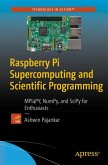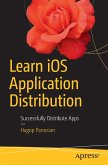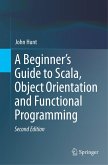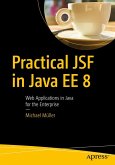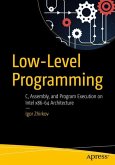- Broschiertes Buch
- Merkliste
- Auf die Merkliste
- Bewerten Bewerten
- Teilen
- Produkt teilen
- Produkterinnerung
- Produkterinnerung
Go Recipes: A Problem-Solution Approach provides an invaluable reference to using the Go programming language, showing idiomatic and best practice code for solving common problems encountered by developers in all industries.
Each recipe tackles a single problem, showing one or more ways to solve it with fully working code accompanied by a discussion of the techniques and language features. Common pitfalls and performance issues are explained, helping you streamline your development and rapidly create robust working code.
This book provides solutions for creating fast, reliable and secure…mehr
Andere Kunden interessierten sich auch für
![Raspberry Pi Supercomputing and Scientific Programming Raspberry Pi Supercomputing and Scientific Programming]() Ashwin PajankarRaspberry Pi Supercomputing and Scientific Programming45,99 €
Ashwin PajankarRaspberry Pi Supercomputing and Scientific Programming45,99 €![Game Development with Construct 2 Game Development with Construct 2]() Lee StemkoskiGame Development with Construct 245,99 €
Lee StemkoskiGame Development with Construct 245,99 €![Learn iOS Application Distribution Learn iOS Application Distribution]() Hagop PanosianLearn iOS Application Distribution29,99 €
Hagop PanosianLearn iOS Application Distribution29,99 €![Exploring Swift Playgrounds Exploring Swift Playgrounds]() Jesse FeilerExploring Swift Playgrounds29,99 €
Jesse FeilerExploring Swift Playgrounds29,99 €![A Beginner's Guide to Scala, Object Orientation and Functional Programming A Beginner's Guide to Scala, Object Orientation and Functional Programming]() John HuntA Beginner's Guide to Scala, Object Orientation and Functional Programming45,99 €
John HuntA Beginner's Guide to Scala, Object Orientation and Functional Programming45,99 €![Practical JSF in Java EE 8 Practical JSF in Java EE 8]() Michael MüllerPractical JSF in Java EE 846,99 €
Michael MüllerPractical JSF in Java EE 846,99 €![Low-Level Programming Low-Level Programming]() Igor ZhirkovLow-Level Programming76,99 €
Igor ZhirkovLow-Level Programming76,99 €-
-
-
Go Recipes: A Problem-Solution Approach provides an invaluable reference to using the Go programming language, showing idiomatic and best practice code for solving common problems encountered by developers in all industries.
Each recipe tackles a single problem, showing one or more ways to solve it with fully working code accompanied by a discussion of the techniques and language features. Common pitfalls and performance issues are explained, helping you streamline your development and rapidly create robust working code.
This book provides solutions for creating fast, reliable and secure applications; covers the entire Go standard library and the best third party packages; and will have lasting appeal as a reference whenever you need to tackle a new development project.
Hinweis: Dieser Artikel kann nur an eine deutsche Lieferadresse ausgeliefert werden.
Each recipe tackles a single problem, showing one or more ways to solve it with fully working code accompanied by a discussion of the techniques and language features. Common pitfalls and performance issues are explained, helping you streamline your development and rapidly create robust working code.
This book provides solutions for creating fast, reliable and secure applications; covers the entire Go standard library and the best third party packages; and will have lasting appeal as a reference whenever you need to tackle a new development project.
Hinweis: Dieser Artikel kann nur an eine deutsche Lieferadresse ausgeliefert werden.
Produktdetails
- Produktdetails
- Verlag: Apress / Springer, Berlin
- Artikelnr. des Verlages: 978-1-4842-1189-2
- 1st ed.
- Seitenzahl: 260
- Erscheinungstermin: 18. November 2016
- Englisch
- Abmessung: 254mm x 178mm x 15mm
- Gewicht: 501g
- ISBN-13: 9781484211892
- ISBN-10: 1484211898
- Artikelnr.: 42530603
- Herstellerkennzeichnung
- Libri GmbH
- Europaallee 1
- 36244 Bad Hersfeld
- gpsr@libri.de
- Verlag: Apress / Springer, Berlin
- Artikelnr. des Verlages: 978-1-4842-1189-2
- 1st ed.
- Seitenzahl: 260
- Erscheinungstermin: 18. November 2016
- Englisch
- Abmessung: 254mm x 178mm x 15mm
- Gewicht: 501g
- ISBN-13: 9781484211892
- ISBN-10: 1484211898
- Artikelnr.: 42530603
- Herstellerkennzeichnung
- Libri GmbH
- Europaallee 1
- 36244 Bad Hersfeld
- gpsr@libri.de
Shiju Varghese is a solutions architect who specializes in cloud computing solutions and distributed web apps. His current technology focus is on Go, Google Cloud, Azure, and Docker. He has been working with Web technologies since early 2000, and has developed web apps and distributed systems in Go, C#, and Node.js. His areas of interest include cloud solutions architecture, application containers, distributed systems, RESTful microservice architecture, and mobile backend as a service. Shiju has been awarded Microsoft MVP status five times. He is a regular speaker at various technology conferences.
1. Go Idioms
2. Working with Text
3. Dates and Times
4. Concurrency and Locking
5. Files and IO
6. Graphics and Images
7. Building Cloud Services
8. Writing Web Services
9. Algorithms and Data Structures
10. Memory Management
11. Numeric Computing
12. Big Data Analytics
13. Mobile
14. Windows
15. Testing and Debugging
16. Performance
17. Security and Encryption
18. Databases
19. Parsing Go Programs
20. Gotchas
1. Go Idioms
Common programming patterns in Go. Naming and packaging code. Error handling.
2. Working with Text
Manipulating and formatting strings. Character sets and encodings. Templating text.
3. Dates and Times
Parsing and formatting dates and times. Using timers to schedule events. Running code at precise intervals.
4. Concurrency and Locking
Using goroutines to create multithreaded programs. Use channels to coordinate and synchronise threads. Using locks and atomic operations to safely share data between threads.
5. Files and IO
Reading, writing and processing files. Walking file systems and searching for files. Parsing CSV, JSON and XML.
6. Graphics and Images
Reading images and then resizing, compositing and filtering them. Drawing shapes and text. Converting image formats.
7. Building Cloud Services
Writing cloud services with TCP and UDP. Downloading, uploading and processing files, sending email, implementing network protocols.
8. Writing Web Services
Creating a web server with request routing. Handling cookies and serving multiple file types. Writing server logs and recording performance metrics. Using JSON and WebSockets to interact with Javascript browser applications.
9. Algorithms and Data Structures
Sorting and searching data. Writing trees, graphs and lists to organise data.
10. Memory Management
Understanding and avoiding garbage collection. Efficient use of memory. Working with large datasets.
11. Numeric Computing
Writing statistical functions, working with matrices. Using high precision and complex numbers.
12. Big Data Analytics
Performing calculations over streams of data and time series. Map/reduce and dealing with data larger than memory. Parallelizing data analysis.
13. Mobile
How to write programs and games for mobile devices. Compiling Go programs for Raspberry Pi and other devices.
14. Windows
Creating GUIs on Windows and other operating systems. Writing Windows specific code and calling DLLs.
15. Testing and Debugging
Writing tests and test suites. Separating and running different types of test. Using a debugger with Go programs. Using environment variables for runtime debugging.
16. Performance
Benchmarking Go code. Analysing memory use and performance. Optimisation techniques for Go programs. Tuning concurrency options.
17. Security and Encryption
Hashing and verifying passwords with bcrypt. Computing hashes of data streams. Encrypting and decrypting data. Accessing secure cloud services.
18. Databases
Accessing and querying databases such as MongoDB, mySQL, Postgesql, MS SQL Server and Oracle. Using in-memory databases.
19. Parsing Go Programs
Analysing, formatting and checking Go source code. Generating and templating code.
20. Gotchas
Common pitfalls and subtleties of programming with Go.
2. Working with Text
3. Dates and Times
4. Concurrency and Locking
5. Files and IO
6. Graphics and Images
7. Building Cloud Services
8. Writing Web Services
9. Algorithms and Data Structures
10. Memory Management
11. Numeric Computing
12. Big Data Analytics
13. Mobile
14. Windows
15. Testing and Debugging
16. Performance
17. Security and Encryption
18. Databases
19. Parsing Go Programs
20. Gotchas
1. Go Idioms
Common programming patterns in Go. Naming and packaging code. Error handling.
2. Working with Text
Manipulating and formatting strings. Character sets and encodings. Templating text.
3. Dates and Times
Parsing and formatting dates and times. Using timers to schedule events. Running code at precise intervals.
4. Concurrency and Locking
Using goroutines to create multithreaded programs. Use channels to coordinate and synchronise threads. Using locks and atomic operations to safely share data between threads.
5. Files and IO
Reading, writing and processing files. Walking file systems and searching for files. Parsing CSV, JSON and XML.
6. Graphics and Images
Reading images and then resizing, compositing and filtering them. Drawing shapes and text. Converting image formats.
7. Building Cloud Services
Writing cloud services with TCP and UDP. Downloading, uploading and processing files, sending email, implementing network protocols.
8. Writing Web Services
Creating a web server with request routing. Handling cookies and serving multiple file types. Writing server logs and recording performance metrics. Using JSON and WebSockets to interact with Javascript browser applications.
9. Algorithms and Data Structures
Sorting and searching data. Writing trees, graphs and lists to organise data.
10. Memory Management
Understanding and avoiding garbage collection. Efficient use of memory. Working with large datasets.
11. Numeric Computing
Writing statistical functions, working with matrices. Using high precision and complex numbers.
12. Big Data Analytics
Performing calculations over streams of data and time series. Map/reduce and dealing with data larger than memory. Parallelizing data analysis.
13. Mobile
How to write programs and games for mobile devices. Compiling Go programs for Raspberry Pi and other devices.
14. Windows
Creating GUIs on Windows and other operating systems. Writing Windows specific code and calling DLLs.
15. Testing and Debugging
Writing tests and test suites. Separating and running different types of test. Using a debugger with Go programs. Using environment variables for runtime debugging.
16. Performance
Benchmarking Go code. Analysing memory use and performance. Optimisation techniques for Go programs. Tuning concurrency options.
17. Security and Encryption
Hashing and verifying passwords with bcrypt. Computing hashes of data streams. Encrypting and decrypting data. Accessing secure cloud services.
18. Databases
Accessing and querying databases such as MongoDB, mySQL, Postgesql, MS SQL Server and Oracle. Using in-memory databases.
19. Parsing Go Programs
Analysing, formatting and checking Go source code. Generating and templating code.
20. Gotchas
Common pitfalls and subtleties of programming with Go.
1. Go Idioms
2. Working with Text
3. Dates and Times
4. Concurrency and Locking
5. Files and IO
6. Graphics and Images
7. Building Cloud Services
8. Writing Web Services
9. Algorithms and Data Structures
10. Memory Management
11. Numeric Computing
12. Big Data Analytics
13. Mobile
14. Windows
15. Testing and Debugging
16. Performance
17. Security and Encryption
18. Databases
19. Parsing Go Programs
20. Gotchas
1. Go Idioms
Common programming patterns in Go. Naming and packaging code. Error handling.
2. Working with Text
Manipulating and formatting strings. Character sets and encodings. Templating text.
3. Dates and Times
Parsing and formatting dates and times. Using timers to schedule events. Running code at precise intervals.
4. Concurrency and Locking
Using goroutines to create multithreaded programs. Use channels to coordinate and synchronise threads. Using locks and atomic operations to safely share data between threads.
5. Files and IO
Reading, writing and processing files. Walking file systems and searching for files. Parsing CSV, JSON and XML.
6. Graphics and Images
Reading images and then resizing, compositing and filtering them. Drawing shapes and text. Converting image formats.
7. Building Cloud Services
Writing cloud services with TCP and UDP. Downloading, uploading and processing files, sending email, implementing network protocols.
8. Writing Web Services
Creating a web server with request routing. Handling cookies and serving multiple file types. Writing server logs and recording performance metrics. Using JSON and WebSockets to interact with Javascript browser applications.
9. Algorithms and Data Structures
Sorting and searching data. Writing trees, graphs and lists to organise data.
10. Memory Management
Understanding and avoiding garbage collection. Efficient use of memory. Working with large datasets.
11. Numeric Computing
Writing statistical functions, working with matrices. Using high precision and complex numbers.
12. Big Data Analytics
Performing calculations over streams of data and time series. Map/reduce and dealing with data larger than memory. Parallelizing data analysis.
13. Mobile
How to write programs and games for mobile devices. Compiling Go programs for Raspberry Pi and other devices.
14. Windows
Creating GUIs on Windows and other operating systems. Writing Windows specific code and calling DLLs.
15. Testing and Debugging
Writing tests and test suites. Separating and running different types of test. Using a debugger with Go programs. Using environment variables for runtime debugging.
16. Performance
Benchmarking Go code. Analysing memory use and performance. Optimisation techniques for Go programs. Tuning concurrency options.
17. Security and Encryption
Hashing and verifying passwords with bcrypt. Computing hashes of data streams. Encrypting and decrypting data. Accessing secure cloud services.
18. Databases
Accessing and querying databases such as MongoDB, mySQL, Postgesql, MS SQL Server and Oracle. Using in-memory databases.
19. Parsing Go Programs
Analysing, formatting and checking Go source code. Generating and templating code.
20. Gotchas
Common pitfalls and subtleties of programming with Go.
2. Working with Text
3. Dates and Times
4. Concurrency and Locking
5. Files and IO
6. Graphics and Images
7. Building Cloud Services
8. Writing Web Services
9. Algorithms and Data Structures
10. Memory Management
11. Numeric Computing
12. Big Data Analytics
13. Mobile
14. Windows
15. Testing and Debugging
16. Performance
17. Security and Encryption
18. Databases
19. Parsing Go Programs
20. Gotchas
1. Go Idioms
Common programming patterns in Go. Naming and packaging code. Error handling.
2. Working with Text
Manipulating and formatting strings. Character sets and encodings. Templating text.
3. Dates and Times
Parsing and formatting dates and times. Using timers to schedule events. Running code at precise intervals.
4. Concurrency and Locking
Using goroutines to create multithreaded programs. Use channels to coordinate and synchronise threads. Using locks and atomic operations to safely share data between threads.
5. Files and IO
Reading, writing and processing files. Walking file systems and searching for files. Parsing CSV, JSON and XML.
6. Graphics and Images
Reading images and then resizing, compositing and filtering them. Drawing shapes and text. Converting image formats.
7. Building Cloud Services
Writing cloud services with TCP and UDP. Downloading, uploading and processing files, sending email, implementing network protocols.
8. Writing Web Services
Creating a web server with request routing. Handling cookies and serving multiple file types. Writing server logs and recording performance metrics. Using JSON and WebSockets to interact with Javascript browser applications.
9. Algorithms and Data Structures
Sorting and searching data. Writing trees, graphs and lists to organise data.
10. Memory Management
Understanding and avoiding garbage collection. Efficient use of memory. Working with large datasets.
11. Numeric Computing
Writing statistical functions, working with matrices. Using high precision and complex numbers.
12. Big Data Analytics
Performing calculations over streams of data and time series. Map/reduce and dealing with data larger than memory. Parallelizing data analysis.
13. Mobile
How to write programs and games for mobile devices. Compiling Go programs for Raspberry Pi and other devices.
14. Windows
Creating GUIs on Windows and other operating systems. Writing Windows specific code and calling DLLs.
15. Testing and Debugging
Writing tests and test suites. Separating and running different types of test. Using a debugger with Go programs. Using environment variables for runtime debugging.
16. Performance
Benchmarking Go code. Analysing memory use and performance. Optimisation techniques for Go programs. Tuning concurrency options.
17. Security and Encryption
Hashing and verifying passwords with bcrypt. Computing hashes of data streams. Encrypting and decrypting data. Accessing secure cloud services.
18. Databases
Accessing and querying databases such as MongoDB, mySQL, Postgesql, MS SQL Server and Oracle. Using in-memory databases.
19. Parsing Go Programs
Analysing, formatting and checking Go source code. Generating and templating code.
20. Gotchas
Common pitfalls and subtleties of programming with Go.


